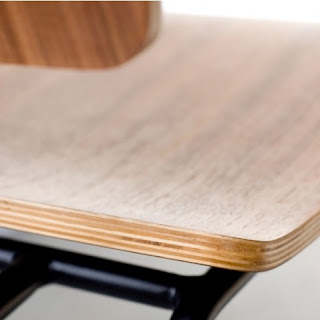Saturday, March 9, 2013
Custom Bed by Walsworth Furnishings
It's like a dream. Too good to be true. We finally got a new bed! Moving up from a Full to a Queen size bed is luxury enough. But we upgraded our mattress and bedframe as well. Zach and I are thrilled!
Custom made of reclaimed wood and metal with storage drawers on both sides. Thanks to Wes Walsworth for building this beautiful bed and following my random design. Wes does amazing work and has a wonderful artistic touch. See more of his work here: http://walsworthfurnishings.com/
Now to get some sleep before the new baby arrives. Sweet dreams :)
Friday, September 28, 2012
Valley Style Makers
I've been BUSY which is never a bad thing but I've neglected my faithful blog for too long. A new article came out in the Sun Valley Magazine on yours truly. Always nice to have some local support.

 When Sarah Latham named her interior design business White Canvas Designs, she had a clean slate in mind—a white board, if you will—an idea that would lead to more possibilities. Today, many of those possibilities, oddly enough, seem to be green.
When Sarah Latham named her interior design business White Canvas Designs, she had a clean slate in mind—a white board, if you will—an idea that would lead to more possibilities. Today, many of those possibilities, oddly enough, seem to be green.
 “Sustainable design can be as complex as a LEED-certified building [LEED is an acronym for Leadership in Energy and Environmental Design, a rating system developed by the U.S. Green Building Council to measure green building design, construction and maintenance]or as simple as a home furnished in an environmentally friendly way,” she explained. “Making a home green is really up to the individual, but it’s something I have knowledge of and I like to give my clients the ability to choose.”
“Sustainable design can be as complex as a LEED-certified building [LEED is an acronym for Leadership in Energy and Environmental Design, a rating system developed by the U.S. Green Building Council to measure green building design, construction and maintenance]or as simple as a home furnished in an environmentally friendly way,” she explained. “Making a home green is really up to the individual, but it’s something I have knowledge of and I like to give my clients the ability to choose.”
Valley Style Makers
How a local designer, architect, developer and store owner created their own unique style in the Valley.

Interior designer Sarah Latham sources a lot of local labor and craftsmen in the Valley.
Shades of Green
SARAH LATHAM, DESIGNER

Sarah Latham, Designer. Photo Five B Studios
Founded “by accident” while working part time as a designer for Ruscitto | Latham | Blanton Architectura (RLB), a local architecture firm, White Canvas was born when Latham got increasing referrals from clients and their friends. Seven years later, she continues to do both jobs.
An artist by training, Latham earned degrees in fine art and journalism from the University of Colorado. Upon graduation, she found herself loath to “sell my paintings on street corners,” as she put it, so she moved to San Francisco and worked as an apprentice with interior design firm Fisher Weisman. In the process of learning the business, she found her interest in green design peaked.
 “Sustainable design can be as complex as a LEED-certified building [LEED is an acronym for Leadership in Energy and Environmental Design, a rating system developed by the U.S. Green Building Council to measure green building design, construction and maintenance]or as simple as a home furnished in an environmentally friendly way,” she explained. “Making a home green is really up to the individual, but it’s something I have knowledge of and I like to give my clients the ability to choose.”
“Sustainable design can be as complex as a LEED-certified building [LEED is an acronym for Leadership in Energy and Environmental Design, a rating system developed by the U.S. Green Building Council to measure green building design, construction and maintenance]or as simple as a home furnished in an environmentally friendly way,” she explained. “Making a home green is really up to the individual, but it’s something I have knowledge of and I like to give my clients the ability to choose.”
Latham met her future husband in Lake Tahoe and he brought her to Hailey where she fell in love with the landscape. It was a simple twist of fate that her father-in-law was a partner in a firm that needed an interior designer. “I feel lucky to work in an architecture firm because I’ve learned a lot about the mechanics of design. What’s more important in this room—is it the view, the air temperature near the windows or the structural integrity of the building?” Latham mused.
A LEED-certified Associate Professional in Interior Design and Construction, Latham knows what she’s talking about. Karen Brown, who owns a 1970’s era condo on which Latham performed a facelift, swears by her. “Sarah’s very positive and upbeat. She allows you to make your own decisions without letting you make big mistakes. She could almost read my mind at times—I gave her a real general concept of what I wanted and she whittled down the choices to make sure I got what I wanted,” Brown recalled.
The challenges of building green in a mountain town are ubiquitous. “It’s a weights and balances thing. You try to make the best design decisions, because traveling outside of the area for products can defeat the purpose. I try to source a lot of local labor and craftsmen—and there’s an amazing amount of talent right here in this Valley,” noted Latham.
Latham offers prospective clients a free consultation so they can get to know her. “I create relationships with clients and walk away from projects with friends,” she said. “You really need to know clients on a personal level to make sure that you design spaces that make people happy.” -Jody Orr
Read more at Sun Valley Magazine's website: http://www.sunvalleymag.com/Sun-Valley-Home-and-Design/Fall-2012/Style-Makers/
Wednesday, April 18, 2012
Sustain In Style
As featured in the latest Habitat 2012 on stands now.
Sustain In StyleThe hottest new eco-friendly products for the home
text by Sarah Latham
Sustain In StyleThe hottest new eco-friendly products for the home
text by Sarah Latham
 Nest Learning Thermostat debuted late last year to rave reviews. Designed by the brains behind Apple's iPod, Nest is an intelligent device that learns about you and your home, automatically turning the heat down when you're away and guiding you to energy-efficient temperatures when you're home, saving you money and nature resources. nest.com, $249, available at Western States Geothermal, Ketchumd d 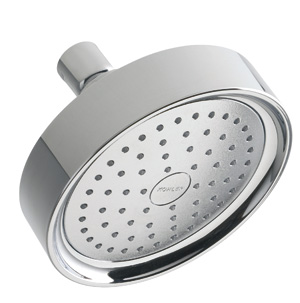 Purist 1.75gpm multifunction showerheadconserves 30 percent more water, satisfying the water efficiency requirement for LEED certification. us.kohler.com, $105, available at Ferguson Kitchen, Bath & Lighting, Hailey 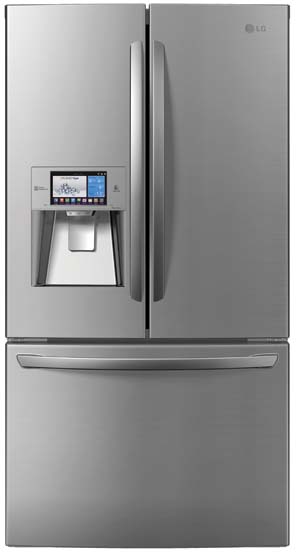 LG super-capacity French door refrigeratorLG super-capacity French door refrigerator debuted at the Consumer Electronics Show in January. This 31-cubic-foot, French-door refrigerator won CES 2012 Best of Innovations Award and its eco-friendly performance garners it EnergyStar approval. lg.com/us/ces/appliances.jsp, price TBD, available at Fisher Appliances, Ketchum |
Wednesday, April 11, 2012
Kitchens For Life
As featured in the latest Habitat 2012 on stands now.
| Kitchens For LifeThree remodels show how to protect the planet while perfecting your space. text by Sarah Latham photos by David N. SeeligThe kitchen's role in the home has morphed from a small, functional footprint to the central room of the house. This shift of the kitchen's function from sole domain of the cook to gathering place for friends and family has prompted many homeowners to consider remodeling. Before ripping out the old and replacing it with new, however, consider the impacts of your remodel on your health and the environment, alongside your aesthetic goals. Energy-efficient appliances, nontoxic finishes, local products and repurposed materials are some of the ways to stay environmentally friendly while expanding your space. Habitat talked to three Wood River Valley homeowners who did just that. | 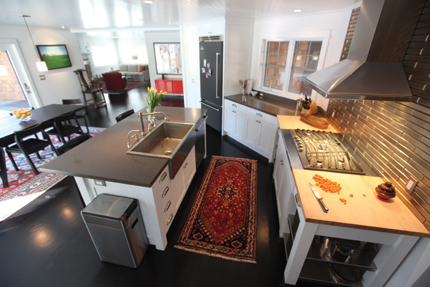 |
| A Small Challenge When Patsy Nickum bought her home in north Hailey, she was faced with a long, galley-style kitchen designed in the 1970s. It was dark and uninviting. She had her work cut out for her. One of her main goals with her remodel was to lighten and open up the space. "The old kitchen was small and narrow and the island was used as the dining table," Nickum said. "It felt claustrophobic, because there was no way to get outside to the backyard. The windows and doors were about 25 years old and had lost their seal, and the glass was fogged." She decided on a complete remodel, and set about creating a new kitchen that would encompass the previous laundry, kitchen, powder room and dining areas. "The first thing we did was demolish a wall that separated the kitchen from the laundry room." The resulting open space became the kitchen/dining room area, and the laundry room was relocated to the master bedroom. A small powder room off the kitchen was gutted and became a repository for the double-wall ovens. The space also houses a small office. As a founder of Rocky Mountain Hardware—a Hailey company that produces hand-cast bronze hardware—Nickum included cabinet pulls, knobs, a kitchen sink, faucet and lighting from the company's product line into her remodel. All of the items contain a minimum of 90 percent post-consumer recycled content and were made in Idaho. "It was challenging taking the existing very funky space and making it work with the vision I had in my head," she said. "I've found that sometimes challenging situations like this bring out creative and innovative results." | 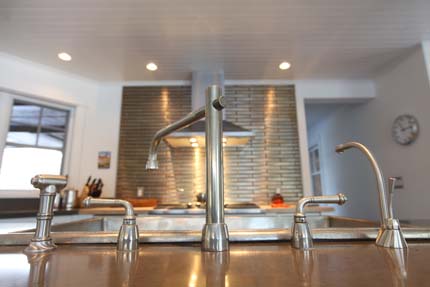 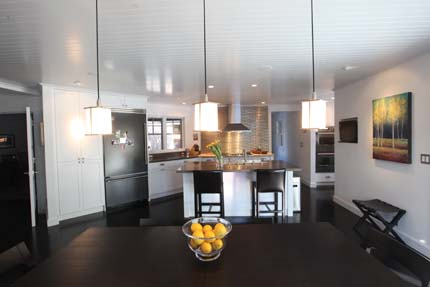 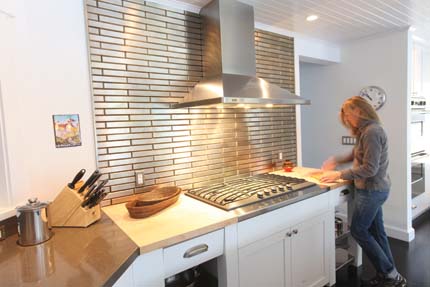 |
| A Family Favorite "We really loved our old kitchen, but it was small and difficult to move around in with two people working," said Heidi Reeves of her home in Deerfield, Hailey. "We wanted a space where we could have multiple projects going and not run into each other." The Reeves' original kitchen encompassed a cramped 8- by 12-foot area with outdated appliances, a tile counter top and limited storage capacity. After working with architects and an interior designer at Ruscitto Latham Blanton and hiring contractor Lee Gilman, the Reeves created a new space, which at one point during the Christmas holidays held 26 family members. "For us, it was about family," Reeves said. "We envisioned a space where we could all cook, read, work, play music, do art, create and be together. We also have a large extended family here, and Sunday dinners are a tradition. It's nice to be able to fit all the cousins at one table and have an adult table to spare." With a fresh start, the Reeves had the opportunity to incorporate environmentally friendly upgrades into their kitchen. Energy Star appliances replaced 10-year-old models. Two recycling spots were added into the cabinetry layout to make it an easy option. Instead of replacing all the existing lighting, a new light pendant was found to match the old ones and refinished to cast more light in the remodeled kitchen. On the walls, American Clay (a nontoxic, VOC-free finish) was used throughout the kitchen and downstairs living area, improving the home's air quality as well as its appearance. | 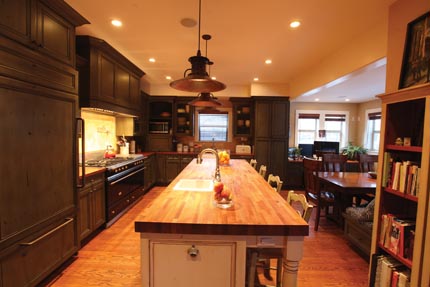 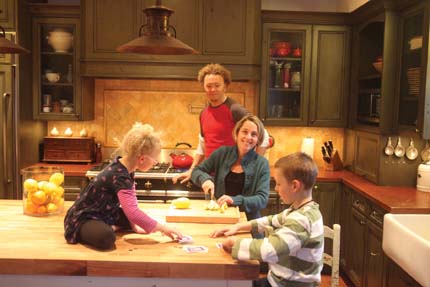 |
| A Need for Space David Lloyd was faced with a unique challenge when a family asked his company, Lloyd Construction, to re-imagine the kitchen of their Weyyakin home, south of Ketchum. "One of the main goals was to create a space that was functional, updated and tied into the rest of the house—an open and inviting room to accommodate large family gatherings," Lloyd said. But the space was small and awkward, and severely hampered by an oddly-situated wall separating the kitchen from the living room. "Mentally, the most difficult and rewarding part of the project was removing that wall," Lloyd said. Once that task was done, the rooms were no longer a limiting factor to the home. Repurposing original kitchen cabinet boxes and designing within the existing kitchen space helped save materials, reduce costs and keep waste out of landfills. "The new kitchen is a night-and-day difference from what was there before—it now has great natural light, is very open and flows well." And the best part is that when the whole family is in town, no one is left out of the action. | 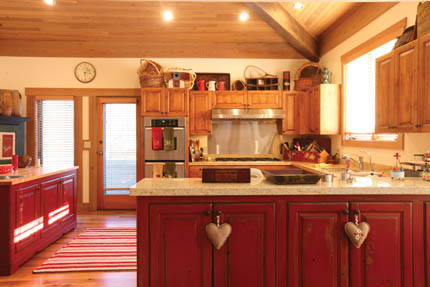 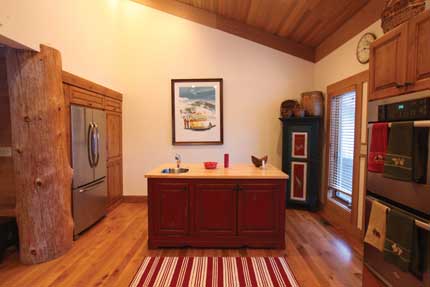 |
Thursday, December 1, 2011
O' Shopping Tree
Tis the season to decorate your Christmas tree. Bet you never thought of decorating your tree with shopping carts. Heck, who needs the tree? Why not just make the entire thing out of shopping carts.
Believe it or not, 86 metal shopping
carts were balanced atop one another to form this 33-foot-tall holiday tree
which graced the Frank
Gehry-designed Edgemar mall in Santa Monica, California last year. Designed
by artist Anthony Schmitt, this beacon of holiday spirit attracted a lot of
attention with its glittering good looks and rather unconventional
material.
“The shopping cart tree symbolizes both generosity and abundance, as well as
acknowledging those less fortunate where their whole world may be housed in a
cart. We see shopping carts every day and take them for granted. Individually
the beauty of an everyday object may become invisible, but in quantity you can’t
miss it,” says Anthony Schmitt of his design.
This actually isn’t the first time that the shopping cart tree has gone up – Schmitt conceived the idea 14 years ago at the request of Abby Sher, the former owner and developer of Edgemar, and the Colwell and Belden families have continued the annual tradition of commissioning the tree since buying Edgemar in 2007.
The 2010 tree is made out of mostly full size carts with some smaller versions at the top to create a forced perspective of height. The carts are supported by an internal structure that remains nearly invisible, allowing the carts to seem like they were merely stacked atop one another and left in that perilous formation.
This actually isn’t the first time that the shopping cart tree has gone up – Schmitt conceived the idea 14 years ago at the request of Abby Sher, the former owner and developer of Edgemar, and the Colwell and Belden families have continued the annual tradition of commissioning the tree since buying Edgemar in 2007.
The 2010 tree is made out of mostly full size carts with some smaller versions at the top to create a forced perspective of height. The carts are supported by an internal structure that remains nearly invisible, allowing the carts to seem like they were merely stacked atop one another and left in that perilous formation.
Monday, August 15, 2011
Eco2Cotton
Have you heard of it?
Ecologically responsible clothing, home and building products that are made using a unique manufacturing process that helps conserve our precious natural resources: land, water and energy.
Pre-consumer fibers and clippings are collected after the cut and sew process, sorted by color and blended. The resulting cotton-like fluff can be used as a fill for stuffing and pads or for spinning new solid and organic looking yarns.
Pre-consumer fibers and clippings are collected after the cut and sew process, sorted by color and blended. The resulting cotton-like fluff can be used as a fill for stuffing and pads or for spinning new solid and organic looking yarns.
Environmental Benefits:
Reduces incinerator and landfill use, by reprocessing pre-consumer textile waste.
Reduces incinerator and landfill use, by reprocessing pre-consumer textile waste.
Cotton fibers require no new dyeing, saving water and adding no new pollutants.
Cotton fibers require no land use, intensive water irrigation, and no new fertilizers or pesticides.
Simplified manufacturing process reduces energy and resource use.
Eco Pillows for the home using Eco2Cotton:
Contact White Canvas Designs if your interested in learning more about this great product.
Eco Pillows for the home using Eco2Cotton:
Contact White Canvas Designs if your interested in learning more about this great product.
Tuesday, August 2, 2011
Back to School
...or back to work more like it. But it feels like back to school! Just wanted to say hello after a long absence from the work world. I hope you are still out there and interested in green design because I will be blogging about new ideas and products for your viewing pleasure. Ready, set, go!
xoxo
Sarah
xoxo
Sarah
Monday, May 2, 2011
Nurseries for Nature
 |
| Grace embraces her sister, Maeve, in the environmentally friendly nursery created by their mother, Anne Mulick. |
Nurseries for Nature
by Sarah Latham
Sun Valley Guide Habitat Magazine
photos by Kirsten Shultz
Sustainable interior designer and expectant mother Sarah Latham entices local moms to share their secrets for creative and healthy children’s rooms.
Quite soon after discovering I was pregnant with my first child, I made a second startling discovery: Babies need stuff. A lot of stuff. Not only that, but there’s a daunting multitude of options, and with all the health concerns and product warnings facing a first-time mother, the fear of getting the wrong item is magnified. So I set out to determine which products would be the healthiest for my baby and the environment.
According to the U.S. Green Building Council’s Green Home Guide, the most important step is to reduce exposure to toxic chemicals. Babies’ immune, hormonal and nervous systems are still developing, meaning environmental pollutants affect them more than they do adults. Creating a green nursery is incredibly important to a child’s health since newborns spend an average of 16 to 17 hours a day there.
I wanted to create a nursery where I wouldn’t have to worry about chemicals, toxins or other hazardous materials. I wanted to make my child’s room safe and green.
For answers and advice, I turned to the community of Wood River Valley mothers to glean from their experiences just how best to envelop my child in a healthy and sustainable environment.
Anne Mulick designed the rooms of her daughters, Maeve, 1, and Grace, 7, with the environment in mind. “It gives us peace of mind that we are doing the right thing,” she said.
The key ingredient for any green nursery is the paint. Benjamin Moore Aura paints are a low-VOC, low-odor, acrylic paint that releases no or minimal volatile organic compounds, though they’re more expensive than standard paint (a gallon of regular Benjamin Moore starts at $34, its Aura paint starts at $58). “The paint seemed like a logical choice,” Mulick said. “Why wouldn’t we do that for our girls?”
An area rug made of 100 percent wool in Maeve’s room also contributes to better air quality. Wool and other raw, natural materials don’t require the use of VOCs or other chemicals that are known carcinogens (such as benzene and formaldehyde), substances commonly found in synthetic floor coverings. They also contribute to the use of rapidly renewable, local and environmentally friendly practices in growing.
This is why it is also important to choose natural, and if possible, organic materials for the child’s bed. The Green Home Guide recommends real wood, natural finishes and untreated pure cotton and wool (preferably organic) bedding.
 |
| Holden Kinman enjoys racing his cars on the oak floors with his mother, Becky. |
Kinman offset the expense of the crib by using repurposed items for the rest of the room’s furniture. “They were items we had used in other parts of our house and incorporated into his room instead of purchasing new,” Kinman said. “So it almost felt like a wash.” Reusing existing furnishings cuts the demand for raw, virgin materials and eliminates landfill waste. An added bonus is that the items often have special meaning for the family. Old apple crates, salvaged from Holden’s grandparents’ farmhouse, were transformed into bookshelves, and a dresser from Kinman’s childhood doubled as a changing table. “We tried to make it a fun blend of whimsical art and color, along with some modern touches,” she said.
Mulick also opted to use hand-me-down, recycled and repurposed items to offset the cost of the pricier green items. An old chair passed down from Mulick’s parents was easily adjusted to the nursery courtesy of a new slipcover. “I like the nostalgia of reusing pieces from a different time into a different space,” Mulick said. Artwork from her childhood was framed and reused as decorative pieces in the girls’ rooms.
Lisa and Nate Scales came up with a practical solution for one of the biggest contributors to indoor air pollution in children’s rooms: plastic toys. They made their own.
After searching for a step stool for their two daughters, Ripley, 4, and Daisy, 1, the Hailey couple was disappointed in their choices. “They were expensive, poor quality and not the size we were looking for,” said Lisa. Fortunately, Nate, a carpenter, set about making the perfect one from wood, decorating it with no-VOC paint.
“We had so much fun with that project, so we started looking for the next toy to build and came up with the toy kitchen,” Lisa said. “It was really a great learning experience for Ripley to watch the transformation of the pieces of wood she was sanding turn into her kitchen.”
Using mainly leftover wood and salvaged scraps of pine from their wood pile, the Scales have so far created a step stool, a kitchen set (complete with over-easy eggs, noodles, tomatoes and lettuce made out of felt), a baby carrier, trees, animals, blocks and a repurposed play house.
The handmade approach is not only environmentally friendly (an assembly-line product uses more energy), but it provides the family with a deeper connection to the products they consume. “They mean something to all of us, because we all have contributed to the final product rather than some plastic, store-bought toy that has no significance,” she said.
If making your own is not an option, opt for cloth and wooden toys, available at local shops such as The Toy Store. Where plastic is unavoidable, choose PVC-free (PVC is usually identified by the number 3 in the recycling symbol) and when in doubt, smell it. Toxic softeners give plastics that strong new smell.
 |
| Ripley and Daisy Scales play in the handmade kitchen they built with their parents. |
Sarah's Sustainable Selections when designing a nursery for my first child, I wanted the room to be environmentally friendly, inexpensive and gender-neutral, as well as to have simple, fun shapes and colors.
MATERIALS I focused on finding cotton or organic products as much as possible. Washable was important to make sure I can continually clean the items.
PAINT I selected green and white Benjamin Moore Natura no-VOC wall paint (starting at $58 a gallon). I plan on painting a tree silhouette with two shades of green leaves and a brown trunk. If we have a girl, I’ll add pink accents. It’s important to finish painting at least a month before baby arrives to allow any off-gasses time to dissipate. If time doesn’t permit this, curing the room with a space heater will also do the trick.
FLOORING A striped, green, 100-percent-cotton woven rug, made by New York-based Dash & Albert, will be the centerpiece of the floor over our existing wool carpet. These rugs are lightweight, reversible, washable and affordable ($28-$385). When choosing flooring, the best option is mostly bare, embellished with a rug or two with nonslip pads, as this is easy to clean. But don’t rip up old carpet, just clean it well.
FURNITURE For the crib, I wanted as natural a sleeping environment as possible, so I decided on a crib from Dwell Studio, an environmentally responsible company based in New York City. The Century Crib ($980) is made in Canada out of solid European beech wood and painted with nontoxic paints. I selected an Ikea dresser made from renewable material (wood fibers), which will easily be separated for recycling after its lifetime. My husband, Zach, and his father, Nick, have built a changing table out of repurposed wood from our garage to place on top. For those nighttime feedings, I found a vintage rocking chair at a garage sale. I plan to make a cushion for it from environmentally friendly fabric company Mod Green Pod’s Grand Jubilee Chocolate pattern. The fabric is 100 percent organic cotton and retails at $40 a yard.
BEDDING For the bedding, I also went with Dwell Studio, known for its colorful and whimsical patterns. I opted for its Owl Sky crib set ($360), which is 100 percent cotton and uses low-impact fiber-reactive dyes and eco-friendly pigments. The owl theme is gender-neutral and gives the room a sweet, playful sensibility.
upkeep After all this hard work and research, I’ll be sure to keep the nursery safe by using natural and nontoxic cleaning products and pest controls.
Sarah Latham LEED AP ID +C (Leadership in Energy & Environmental Design Associate Professional Interior Design & Construction), is the owner of White Canvas Designs. She is expecting her first child in April.
Friday, April 29, 2011
Skirt Into Tent
This cracks me up, especially because we have been considering camping options now that we will have a new baby. I'm showing this to my husband as a serious option.
Need Space? “Portable Home” is a Skirt That Transforms Into a Tent
by Jasmin Malik Chua, 03/28/11
Photos by Abi Jones
Who says you can’t take it with you? “Portable Home,” a wearable-shelter concept by three Middlesex University students in London, is part wacky ensemble, part escape strategy. Franziska Lusser, Hanna Nielsen, and Luca Romanyi, who hail from Germany, Sweden, and Hungary, respectively, designed Portable Home as a response to their nomadic existence. “As all of us are foreigners, we feel like we are always on the go,” Romanyi tells Ecouterre. “We have access to only a small part of our belongings. A ‘portable home’ can be seen as substitute for the feeling of being home.”
A TENT OF ONE’S OWN
In addition to a skirt that turns into a tent (complete with a window view), the outfit also includes a bag that unfolds into a shelf for displaying books and other mementos. At its crux, Portable Home describes the conflict between the desire to explore and our longing for the familiar.
At its crux, Portable Home describes the conflict between the desire to explore and our longing for the familiar.
“We get the chance to travel all around the world, study in different countries, learn about other cultures, and make new friends with various backgrounds, which is great,” Romanyi explains. “But on the other hand, during our journey, we always leave precious people and places behind.”
An itinerant way of life—one that is as familiar to refugees as it is to international students—translates to temporary accommodations and a limited number of possessions. “This kind of lifestyle is liberating and frustrating at the same time, and Portable Home represents both sides of it,” she adds.
See more pictures here.
Need Space? “Portable Home” is a Skirt That Transforms Into a Tent
by Jasmin Malik Chua, 03/28/11
Photos by Abi Jones
Who says you can’t take it with you? “Portable Home,” a wearable-shelter concept by three Middlesex University students in London, is part wacky ensemble, part escape strategy. Franziska Lusser, Hanna Nielsen, and Luca Romanyi, who hail from Germany, Sweden, and Hungary, respectively, designed Portable Home as a response to their nomadic existence. “As all of us are foreigners, we feel like we are always on the go,” Romanyi tells Ecouterre. “We have access to only a small part of our belongings. A ‘portable home’ can be seen as substitute for the feeling of being home.”
A TENT OF ONE’S OWN
In addition to a skirt that turns into a tent (complete with a window view), the outfit also includes a bag that unfolds into a shelf for displaying books and other mementos. At its crux, Portable Home describes the conflict between the desire to explore and our longing for the familiar.
At its crux, Portable Home describes the conflict between the desire to explore and our longing for the familiar.
“We get the chance to travel all around the world, study in different countries, learn about other cultures, and make new friends with various backgrounds, which is great,” Romanyi explains. “But on the other hand, during our journey, we always leave precious people and places behind.”
An itinerant way of life—one that is as familiar to refugees as it is to international students—translates to temporary accommodations and a limited number of possessions. “This kind of lifestyle is liberating and frustrating at the same time, and Portable Home represents both sides of it,” she adds.
See more pictures here.
Wednesday, April 27, 2011
Bright Recycled Rugs
This reversible indoor-outdoor rug from Mad Mats®, in an exotic Moroccan pattern, is made from recycled plastic bottles and packing materials. Its tubular threads absorb no stains, can easily be cleaned with garden hose or sponge, and won't trap water or mildew. Carefree and 100% earth friendly, too.
Get yours from VivaTerra starting at $42. I need to find a place in our house to put one of these beauties.
Get yours from VivaTerra starting at $42. I need to find a place in our house to put one of these beauties.
Monday, April 25, 2011
Reclaimed Vintage Lighting
I have an appreciation for these fixtures as I tried to take the "easy" route and order something similar from Pottery Barn. After it arrived to our house I realized that the hanging dimensions were far from what we needed on our sloped ceiling. Like everything else in our house I knew we would need to customize to get it right.
Here are images from a company called Reclaimed Lighting in Atalanta. I'm hoping we can accomplish the same look in our dining area on a very small budget. We will see how my husband does with glass cutting and I'll let you know our progress.
Friday, April 22, 2011
Handmade Broom Set
This broom set makes me happy :) All of a sudden cleaning up is fun again.
100% renewable sorghum is combined with intricately woven, vibrant handles by artisans in Thailand to produce durable brooms colored with nontoxic dyes. Crafted one at a time, this attractive broom and dustpan handle any sweeping assignment with style and efficiency. To clean up small spills, we've included a matching whisk broom. Set includes full-size and whisk brooms and dust pan.
Get yours here. Starting at $55.
100% renewable sorghum is combined with intricately woven, vibrant handles by artisans in Thailand to produce durable brooms colored with nontoxic dyes. Crafted one at a time, this attractive broom and dustpan handle any sweeping assignment with style and efficiency. To clean up small spills, we've included a matching whisk broom. Set includes full-size and whisk brooms and dust pan.
Get yours here. Starting at $55.
Wednesday, April 20, 2011
Gus Modern School Chair
From Gus this standard school chair style is recreated for modern seating. The simple design lends itself to a familiar and "classey" look.
Powder coated frame in a walnut finish.
31"H x 17"W x 20"D
Contact White Canvas Designs to go back to school with this chair style :)
Powder coated frame in a walnut finish.
31"H x 17"W x 20"D
Contact White Canvas Designs to go back to school with this chair style :)
Monday, April 18, 2011
Paul Vincent Wiseman
Great article on this Bay Area designer that was often confused with Jeffry Weisman (my mentor).
Read the article here in Decorati.
Read the article here in Decorati.
Thursday, April 14, 2011
Alphabet Nightlight
Finally, a cute night light that doesn't look like you bought it at the hardware store.
Just what we need for our little one's arrival. Starting at $39 contact White Canvas Designs to get yours.
Just what we need for our little one's arrival. Starting at $39 contact White Canvas Designs to get yours.
Wednesday, April 13, 2011
Kamibashi Reusable Freak-O-Bags
By now you’ve probably amassed a good number of reusable grocery bags, but here’s one more worth adding to your collection — that will get your kids in on the green action too. Kamibashi Freak-O-Bags start as quirky and colorful Asian art-inspired characters and unfold into sturdy, 16-inch square bags. Each one comes with a carabiner clip so you can hang it on the stroller for your little one to play with or ogle on the way to the store. North Carolina designer Julie Armbruster created these novel Fair Trade bags, some of which she makes herself, and some of which are handmade by a family in Thailand.
by Julie Knapp, get yours here starting at $20.
by Julie Knapp, get yours here starting at $20.
Tuesday, April 12, 2011
Transparent Green Wall Sconce
Gorgeous transparent green glass wall sconce from Produzione Privata Acquaparete. Designed by Michele de Lucchi in Murano glass it's 7.9"H x 4.5"Dia.
Contact White Canvas Designs for pricing and availability.
Contact White Canvas Designs for pricing and availability.
Friday, April 8, 2011
New Cork Floor
We did this in March but thought it was a worthy post for WCD.
We purchased the cork planks through Sustainable Flooring in Boulder, Colorado. The warmth and acoustic value of our new laundry room flooring was immediately apparent. Read below for more specific information on the cork itself.
Sustainability Benefit:
Cork from Portugal is sustainable for a number of reasons. Firstly, it is rapidly renewable, being that the bark of the tree is peeled from the trunk, and then tree is left to regenerate. This provides an almost limitless supply of cork bark, assuming that once the tree is beyond its’ useful life, replacements are planted (which they are). This heavily protected species also carries with it tremendous mechanical and functional properties, most of which are related to the fact that the cork bark is made almost entirely of cellular pockets of air (200 million cells per cubic inch). These cells of trapped air inhibit the passage of sound (making it one of the best acoustic insulators known), and are known as a thermal insulator, separately an often cold floor from the warmth of your foot. In addition, cork is anti-microbial, has tremendous “bounce-back” properties and forgiveness, and offers one of the greatest slip resistances of any natural material. Despite common wine industry myths, cork availability increases every year (despite minor ups and downs related to weather), and is one of the true really sustainable raw materials in its unaltered state.
Sustainable Flooring uses “ceramic” and “atomic” finishes (enabling extremely high-traffic commercial use)
Organic wax coating applied to all sides of the T&G (for added moisture resilience)
Offers tremendous slip resistance (unmatched with any other mosaic)
Sustainable Flooring only sources cork from Portugal (not China, where the cork forests are not mature enough to provide the inherent benefits in the cork material)
Core material in planks is CARB-compliant (E0)
After months of planning, Zach sacrificed most of this past weekend to install our new laundry room cork flooring. He and I tackled the removal of our existing linoleum flooring on Saturday afternoon and then a good friend, Ian, came in on Sunday and installed the new cork with Zach. Thank goodness for Ian's help! We couldn't have done it without him :)
 |
| Bye, bye, nasty linoleum |
 |
| Yuck! Time to go. |
 |
| Ian and Zach laying in the first row. |
 |
| Job well done boys. We are back in business. |
 |
| Ceramic Infused Cork plank flooring...aahhh! |
Sustainability Benefit:
Cork from Portugal is sustainable for a number of reasons. Firstly, it is rapidly renewable, being that the bark of the tree is peeled from the trunk, and then tree is left to regenerate. This provides an almost limitless supply of cork bark, assuming that once the tree is beyond its’ useful life, replacements are planted (which they are). This heavily protected species also carries with it tremendous mechanical and functional properties, most of which are related to the fact that the cork bark is made almost entirely of cellular pockets of air (200 million cells per cubic inch). These cells of trapped air inhibit the passage of sound (making it one of the best acoustic insulators known), and are known as a thermal insulator, separately an often cold floor from the warmth of your foot. In addition, cork is anti-microbial, has tremendous “bounce-back” properties and forgiveness, and offers one of the greatest slip resistances of any natural material. Despite common wine industry myths, cork availability increases every year (despite minor ups and downs related to weather), and is one of the true really sustainable raw materials in its unaltered state.
Sustainable Flooring uses “ceramic” and “atomic” finishes (enabling extremely high-traffic commercial use)
Organic wax coating applied to all sides of the T&G (for added moisture resilience)
Offers tremendous slip resistance (unmatched with any other mosaic)
Sustainable Flooring only sources cork from Portugal (not China, where the cork forests are not mature enough to provide the inherent benefits in the cork material)
Core material in planks is CARB-compliant (E0)
Wednesday, April 6, 2011
New Tile Trends at Coverings Show
I didn't make this years show but thought I would share another's experience.
From the Fresh Home Blog:
Last week, I found myself in Vegas. That’s right, Sin City. And while I spent one fine evening losing my money at the roulette table (wait, I played until 3AM, so that should read “one fine morning”), I was actually invited there to take in the Coverings 2011 show. Billed as the ultimate stone and tile experience—1000+ exhibitors from 50+ countries—I can assure you it delivered. Now I understand why people go gaga over this stuff! Here are five trends or innovations that I found fascinating. (More to come later, I promise.)
1) Amazing ink jet technology that produces high-definition porcelain and ceramic tile meant to mimic the look of natural stone or well-worn wood. Companies like Florida Tile have elevated this to an art form. And the glazing technology is amazing, too! With it, they can, quite convincingly, achieve the sophisticated look of polished marble.
2) The resurgence of glass. Now made in almost any thickness, hue, size or shape imaginable, there’s a new standard in glass. It’s stronger and can be used for countertops, partition panels and even benches, much like the one I snapped at the Interstyle Ceramic and Glass booth. And don’t you just love their ripple glass? It’s available in 40+ colors, and you’d swear water flows over its surface. Stunning.
3) Twisted tile. And bent…and stretched…and weaved together. Tile is being manipulated any which way, and the results are drool worthy. Cover an entire wall or add a simple strip to up the visual ante. Love the Evolution collection from Apavisa with all its texture and dark, sexy color.
4) Media mash-ups are hot. Glass + metal + mirror + ceramic = hello, gorgeous. And, believe it or not, so is graffiti! Artfully done via ink jet technology, it’s the epitome of urban chic.
From the Fresh Home Blog:
Last week, I found myself in Vegas. That’s right, Sin City. And while I spent one fine evening losing my money at the roulette table (wait, I played until 3AM, so that should read “one fine morning”), I was actually invited there to take in the Coverings 2011 show. Billed as the ultimate stone and tile experience—1000+ exhibitors from 50+ countries—I can assure you it delivered. Now I understand why people go gaga over this stuff! Here are five trends or innovations that I found fascinating. (More to come later, I promise.)
1) Amazing ink jet technology that produces high-definition porcelain and ceramic tile meant to mimic the look of natural stone or well-worn wood. Companies like Florida Tile have elevated this to an art form. And the glazing technology is amazing, too! With it, they can, quite convincingly, achieve the sophisticated look of polished marble.
 |
| high-resolution ceramic tile |
 |
| porcelain tile with wood-grain texture |
 |
| ripple-effect glass |
 |
| glass-topped bench |
 |
| basket weave tile from Apavisa's Evolution collection |
 |
| tile that looks like it's been stretched and twisted |
 |
| metal and tile |
 |
| graffiti tile |
5) Thin is in. We saw it everywhere! 3.5mm-thick porcelain tiles in large, impressive formats. Use them on walls, on floors, on counters. Easy to handle and cut (so perfect for curvy areas), installation is a breeze. And because it’s low profile, it can go right over an existing floor. Plus, it’s considered eco-friendly because thin tiles are made with less material than traditional tiles and are lighter to transport.
 |
| thin tile |
Enough said. I’m officially a stone and tile geek. Who’s with me?! How do you achieve style with tile?
Read more from this blogger here.
Subscribe to:
Posts (Atom)





















